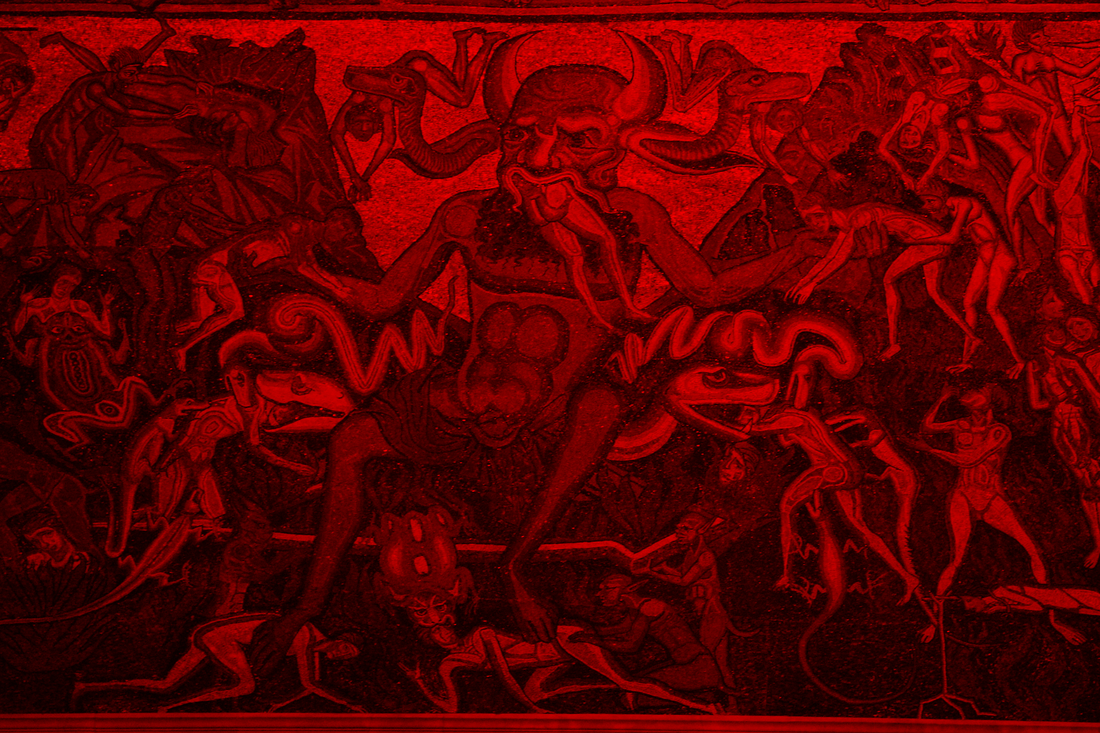
How Many Satanists Are There in the World?
Share
Satanism is often shrouded in mystery and misconception, making it difficult to pin down how many people identify as Satanists worldwide. Popular culture has long fuelled exaggerated narratives, from secretive cults to sinister rituals. In reality, modern Satanism is more about personal freedom, secular activism, and philosophical rebellion than the occult stereotypes suggest.
Despite growing visibility - particularly through groups like the Satanic Temple and the Church of Satan - accurate numbers are hard to come by. Some Satanists join official organisations, while others follow independent paths and avoid labels altogether. Social stigma and fear of backlash can also keep many from publicly identifying as Satanists. But what can the available data tell us about the true size of this global movement? Understanding the landscape of modern Satanism requires looking past the myths and into the facts.
Types of Satanism
Satanism isn’t a monolithic belief system - it encompasses various philosophies and practices, each with its own focus and purpose. The two most prominent groups are the Church of Satan and the Satanic Temple, but there are also many independent or "non-aligned" Satanists who don’t associate with any formal organisation. Understanding these distinctions is key to making sense of the movement’s size and scope.
The Church of Satan
Founded by Anton LaVey in 1966, the Church of Satan was the first formal organisation dedicated to Satanism. It advocates for a philosophy of individualism, indulgence, and scepticism, viewing Satan as a symbol of personal freedom rather than a literal deity. Members of the Church of Satan often identify as atheistic or agnostic and see rituals as symbolic acts for personal empowerment rather than supernatural ceremonies. The Church of Satan does not publicly release its membership numbers, maintaining that Satanism is a personal, not public, declaration.
The Satanic Temple (TST)
Founded in 2013 by Lucien Greaves and Malcolm Jarry, the Satanic Temple is distinct from the Church of Satan in its emphasis on activism and social justice. TST is a non-theistic organisation that uses the figure of Satan as a symbol of rebellion against authoritarianism and religious intrusion into public life. TST is widely known for its legal challenges and public campaigns defending religious freedom and reproductive rights. Unlike the Church of Satan, TST actively builds a global community and publicly acknowledges its growing membership. As of recent reports, the organisation claims tens of thousands of members worldwide, though precise figures are difficult to verify.
Independent Satanists
A significant portion of modern Satanists don’t belong to any formal group. Some follow the principles laid out in The Satanic Bible, while others develop their own interpretations of Satanism, incorporating elements of atheism, anarchism, or even spiritual practices. These individuals may avoid formal membership to maintain their autonomy or to steer clear of public scrutiny. Independent Satanists are often connected through online forums and social media rather than physical chapters or institutions.
Each of these groups has different views on what it means to be a Satanist. Some see it as a philosophy of empowerment and critical thought, while others see it as a symbolic rejection of religious control. The lack of a central authority or uniform definition means that any attempt to count Satanists worldwide must account for these diverse approaches, making reliable statistics difficult to gather.

Photo by Rob Curran on Unsplash
Challenges in Estimating Numbers
Estimating the number of Satanists in the world comes with unique challenges, largely due to social stigma, decentralisation, and varying definitions of what "Satanism" actually entails. Unlike many mainstream religions that have formal structures, congregations, and census-based tracking, Satanism is fragmented and often deliberately private.
Because of these factors, attempts to count the global Satanist population often rely on incomplete data. Most available estimates are educated guesses at best, shaped by the limited information that can be gathered through public statements, online communities, and occasional surveys.
Despite the challenges, there have been some efforts to estimate the number of Satanists globally, although the figures vary depending on the source and methodology. These estimates give some insight into the growth and visibility of modern Satanism but should be taken with caution due to the factors discussed earlier.
United States Data
In the U.S., Satanism has gained significant visibility, especially with the rise of the Satanic Temple (TST). A 2020 report noted that TST had grown to an estimated 300,000 registered members - a sharp increase from its earlier figures of around 10,000 in 2014. However, this number represents registered supporters rather than active participants, and the group’s global presence complicates the data.
In terms of religious surveys, groups like Pew Research tend to bundle Satanists into broader categories of "Other Religions" or "Unaffiliated." This makes it difficult to pinpoint exact numbers, though it’s believed that a small but consistent fraction of self-identified atheists or agnostics also align with Satanic beliefs.
United Kingdom Data
In the 2011 UK Census, 1,893 people explicitly identified as Satanists - a relatively small number. However, experts believe this significantly underrepresents the true figure. The census category for "Other religions" included over 240,000 responses, which likely contained unaffiliated Satanists alongside other alternative spiritual beliefs. Since then, organisations like TST have expanded their reach in the UK, opening local chapters and gaining media attention, which likely increased public awareness and membership.
Australia and Other Countries Data
In Australia’s 2021 census, approximately 1,000 people declared "Satanism" as their religion, a noticeable rise from earlier years. However, as in other countries, many Satanists may choose not to disclose their beliefs due to social stigma. Similar trends have been observed in Canada, where religious studies show a growing category of "spiritual but non-religious" individuals, some of whom identify with Satanic philosophies without joining formal organisations.
Organisational Data
The Church of Satan, which has been active since 1966, does not publicly disclose its membership numbers. The organisation maintains that its philosophy doesn’t require public affiliation and that private adherence is more important than official registration. Estimates suggest that their following may be in the tens of thousands globally, though much of this is speculative.
The Satanic Temple, by contrast, has embraced transparency and public engagement, frequently sharing membership milestones. Their claim of hundreds of thousands of members worldwide, particularly following their high-profile legal campaigns in the U.S., suggests that the movement is growing, particularly among younger generations.
While exact numbers are hard to pin down, the data shows that Satanism is no longer a fringe ideology confined to small circles. The growth of organised groups like the Satanic Temple and the widespread influence of online communities indicate that interest in Satanism - particularly in its secular and activist forms - is steadily increasing. This shift is part of a broader trend of people rejecting traditional religious frameworks in favour of belief systems that prioritise personal freedom, individuality, and scepticism.

Photo by Zoran Zonde Stojanovski on Unsplash
Cultural Shifts
The visibility of Satanism has grown dramatically in recent years, thanks in part to cultural shifts and the digital age. What was once an underground movement is now part of mainstream conversations about religion, freedom of expression, and secularism. Organisations like the Satanic Temple have played a significant role in making Satanism a visible - and often controversial - presence in the public sphere.
The Internet’s Role
Social media platforms and online forums have made it easier for Satanists to find like-minded communities, organise events, and spread their message globally. Platforms such as Reddit, Discord, and Facebook host popular groups where Satanists share ideas, discuss philosophy, and coordinate activism. This online presence has also helped dismantle stereotypes by providing direct access to what modern Satanists actually believe, countering fear-driven misconceptions from the past.
Media Representation
Documentaries like Hail Satan? (2019) have reshaped public perceptions of Satanism. The film provided a behind-the-scenes look at the Satanic Temple’s activism, portraying its members as rational, witty, and deeply committed to their causes. TV shows, films, and music have also contributed to normalising Satanic aesthetics and themes, making them more associated with rebellion, creativity, and empowerment rather than fear.
Legal and Social Activism
The Satanic Temple’s high-profile legal challenges have brought Satanism into the spotlight. Their lawsuits over issues like religious monuments, prayer in public schools, and reproductive rights have made headlines worldwide. These actions have sparked debates about the separation of church and state and challenged the monopoly that mainstream religious groups often hold over public spaces and policies.
Rejection of Traditional Religion
The growth of Satanism coincides with a broader trend of religious disaffiliation. In countries like the U.S., UK, and Australia, more people - particularly younger generations - are identifying as non-religious or "spiritual but not religious." Many who turn away from traditional faiths are drawn to secular belief systems that align with their values of autonomy, justice, and self-expression. Satanism, with its emphasis on personal freedom and scepticism, appeals to those seeking a structured philosophy without supernatural beliefs.
Pop Culture Influence
Satanic symbolism has become increasingly popular in fashion, art, and music. Bands in genres such as metal, punk, and industrial have long embraced Satanic themes, but today, even mainstream artists reference occult imagery as a form of self-expression and rebellion. This cultural embrace of Satanic aesthetics, while not always aligned with the philosophy of groups like the Church of Satan or the Satanic Temple, has contributed to a growing public familiarity with Satanism.
While some still see Satanism as provocative or dangerous, many others now view it as a legitimate philosophy or social movement. The shift in public perception is a testament to how much the cultural landscape has changed. Instead of hiding in the shadows, modern Satanists have embraced visibility, using media, legal battles, and art to challenge outdated narratives and redefine what Satanism means in the 21st century.













